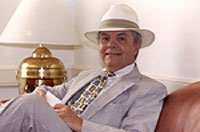 Although born in Connecticut in 1822, John Strong Newberry was only two years old when his family emigrated to Ohio and his father became a founder and pioneer settler in Cuyahoga Falls. As the youngest of eight children, John and his siblings wandered through the Cuyahoga Valley and his early interest in geology was formed by his youthful ramblings in what is now a National Park. When he was about 15, his parents sent him to attend the Preparatory School that we now call WRA. His arrival in 1838 coincided with the opening of the Loomis Observatory and the stellar science faculty that was made up of Elias Loomis and Samuel St. John. He then spent a few years at leisure before returning to Hudson to enroll at Western Reserve College where he graduated with the class of 1846. He went on the the Medical College in Cleveland where he earned a medical degree in 1848, married Sarah Gaylord, and sailed for France where he spent two years studying botany, geology, and medicine in Paris.
Although born in Connecticut in 1822, John Strong Newberry was only two years old when his family emigrated to Ohio and his father became a founder and pioneer settler in Cuyahoga Falls. As the youngest of eight children, John and his siblings wandered through the Cuyahoga Valley and his early interest in geology was formed by his youthful ramblings in what is now a National Park. When he was about 15, his parents sent him to attend the Preparatory School that we now call WRA. His arrival in 1838 coincided with the opening of the Loomis Observatory and the stellar science faculty that was made up of Elias Loomis and Samuel St. John. He then spent a few years at leisure before returning to Hudson to enroll at Western Reserve College where he graduated with the class of 1846. He went on the the Medical College in Cleveland where he earned a medical degree in 1848, married Sarah Gaylord, and sailed for France where he spent two years studying botany, geology, and medicine in Paris. Returning to Cleveland in 1850, Dr. Newberry practiced medicine, became active in the Cleveland Academy of Natural Science, and was the first President of the Cleveland YMCA. In the mid-1850's he was selected to join three major expeditions in the West and was responsible for making a number of important geological discoveries. The most dramatic was an expedition led by Lt. Joseph C. Ives (organized by th
 e U.S. Army) to sail up the Colorado River from the Gulf of California in 1857-58. Their steamboat broke up near the present site of Hoover Dam, but they went on anyway to the Grand Canyon, making the descent from the south rim, and Newberry became the first scientist to do geological work there. In 1859 Newberry was the scientist for the expedition led by Capt. J. N. Macomb that left from Santa Fe to explore the Grand and Green Rivers that feed into the Colorado. In the mid-1850's he had helped map central Oregon where a volcano crater was later named in his honor.
e U.S. Army) to sail up the Colorado River from the Gulf of California in 1857-58. Their steamboat broke up near the present site of Hoover Dam, but they went on anyway to the Grand Canyon, making the descent from the south rim, and Newberry became the first scientist to do geological work there. In 1859 Newberry was the scientist for the expedition led by Capt. J. N. Macomb that left from Santa Fe to explore the Grand and Green Rivers that feed into the Colorado. In the mid-1850's he had helped map central Oregon where a volcano crater was later named in his honor. Although a doctor by profession, Newberry won renown as a geologist and scientist. During the Civil War he held an appointment with the Sanitary Commission in the Mississippi Valley and was on hand to witness the battles around Chattanooga. He later filed an extensive report of his activities and observations. In 1866 he joined the faculty of the School of Mines at Columbia University where he remained for 24 years, although maintaining a home in Cleveland as well. He headed the Ohio Geological Survey for many years, and published a notable Geological Map of Ohio in 1872. In 1888 he became a founder of the Geological Society of America. He published over 200 scientific papers and reports during his lifetime. He died in New Haven in 1892, but was buried at Lakeview Cemetery in Cleveland. Dr. Newberry was survived by seven children. Some of his papers are at the New York Botanical Society and others at the Cleveland Museum of Natural History. A definitive biography of this important 19TH century scientist has yet to be written.
